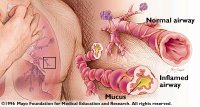There is no cure for asthma
There is no cure for asthma. People with asthma have a chronic and variable, but controllable, condition. Patients can combine education, lung function measurement, avoidance techniques, lifestyle changes and appropriate medications to reduce the likelihood of experiencing symptoms. Such a comprehensive approach is known as asthma management.
The key goals in an asthma management plan include achieving the following:
• Minimal or nonexistent chronic symptoms
• Minimal or nonexistent flare-ups
• No restrictions on physical activity
• No missed work or school days due to asthma
• No emergency room visits or hospital room stays
• Minimal need to use short-acting inhaled beta-agonists
• Minimal or nonexistent side effects due to medications
Once an individual has been diagnosed with asthma, a physician will develop a specific asthma action plan to help the patient monitor the condition.













